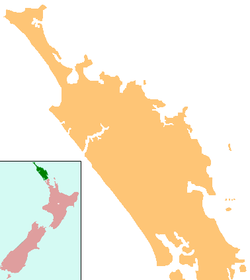Hūkerenui
Hukerenui | |
|---|---|
 Hukerenui | |
| Coordinates: 35°31′13″S 174°12′2″E / 35.52028°S 174.20056°E | |
| Country | New Zealand |
| Region | Northland Region |
| District | Whangarei District |
Hūkerenui is a settlement in Northland, New Zealand. State Highway 1 passes through the area. Kawakawa is northwest, and Hikurangi is southeast.[1][2]
The New Zealand Ministry for Culture and Heritage gives a translation of "large cascade" for Hukerenui.[3]
History[]

The settlement began as Hukerenui South in 1886, with a request made by a group of local people for the land under the Village Homestead Special Settlement system. The village was opened to the first 25 settler families the following year. Although the main road from Whangarei to Kawakawa passed through it, the road was only a dirt track, and was impassable during winter. Gum digging was one of the initial sources of income, but the Government cancelled gum-digging licences after fires in early 1888.[4] A flax mill at Towai provided some jobs. Some were employed to build and improve the roads.[5]
The North Auckland railway line reached Hukerenui in 1901 or 1902.[a] It was extended north to Towai in February or May 1910, and to Kawakawa in 1912 or 1911.[b]
In 2019, the name of the locality was officially gazetted as Hūkerenui.[8]
Demographics[]
| Year | Pop. | ±% p.a. |
|---|---|---|
| 2006 | 1,683 | — |
| 2013 | 1,641 | −0.36% |
| 2018 | 1,923 | +3.22% |
| Source: [9] | ||
The statistical area of Mangakahia-Hūkerenui, which at 659 square kilometres is much larger than this settlement, had a population of 1,923 at the 2018 New Zealand census, an increase of 282 people (17.2%) since the 2013 census, and an increase of 240 people (14.3%) since the 2006 census. There were 627 households. There were 996 males and 927 females, giving a sex ratio of 1.07 males per female. Of the total population, 447 people (23.2%) were aged up to 15 years, 372 (19.3%) were 15 to 29, 885 (46.0%) were 30 to 64, and 222 (11.5%) were 65 or older. Figures may not add up to the total due to rounding.
Ethnicities were 71.6% European/Pākehā, 41.0% Māori, 3.1% Pacific peoples, 1.6% Asian, and 1.7% other ethnicities. People may identify with more than one ethnicity.
The percentage of people born overseas was 10.1, compared with 27.1% nationally.
Although some people objected to giving their religion, 50.5% had no religion, 31.8% were Christian, and 7.3% had other religions.
Of those at least 15 years old, 174 (11.8%) people had a bachelor or higher degree, and 321 (21.7%) people had no formal qualifications. The median income was $26,800. The employment status of those at least 15 was that 735 (49.8%) people were employed full-time, 234 (15.9%) were part-time, and 87 (5.9%) were unemployed.[9]
Education[]
Hukerenui School Years 1–8 is a coeducational full primary (years 1–8) school with a roll of 181 students as of November 2021.[10][11] The school was founded in 1889, and amalgamated with other small schools to a new site in 1949. Hukerenui School moved in 1975 to the site of the former Hukerenui District High School. It changed its name from "Hukerenui School" to "Hukerenui School Years 1–8" in 1997.[12]
The school included a Form 3 class in 1946, and this was expanded into a secondary department. This eventually split to form the Hukerenui District High School, which operated from March 1957 to December 1972.[13]
Notable people[]
Footnotes[]
Notes[]
- ^ Peter Dowling, ed. (2004). Reed New Zealand Atlas. Reed Books. pp. map 5. ISBN 0-7900-0952-8.
- ^ Roger Smith, GeographX (2005). The Geographic Atlas of New Zealand. Robbie Burton. pp. map 24. ISBN 1-877333-20-4.
- ^ "1000 Māori place names". New Zealand Ministry for Culture and Heritage. 6 August 2019.
- ^ Menefy 1988, pp. 5–6.
- ^ Menefy 1988, pp. 10, 29.
- ^ a b Menefy 1988, p. 32.
- ^ a b Hansen & Neil 1992, pp. 86–88.
- ^ "Place name detail: Hūkerenui". New Zealand Gazetteer. New Zealand Geographic Board. Retrieved 2 August 2019.
- ^ a b "Statistical area 1 dataset for 2018 Census". Statistics New Zealand. March 2020. Mangakahia-Hukerenui (104800). 2018 Census place summary: Mangakahia-Hūkerenui
- ^ "New Zealand Schools Directory". New Zealand Ministry of Education. Retrieved 22 December 2021.
- ^ Education Counts: Hukerenui School
- ^ "History". Hukerenui School Years 1–8. Archived from the original on 14 October 2008.
- ^ Menefy 1988, p. 2.
- ^ "James Lynch QSM". James Lynch. Retrieved 16 January 2020.
References[]
- Hansen, Herbert James; Neil, Forbes J. (1992). Tracks in the North. Auckland: H. J. Hansen.
- Menefy, Diana (1988). Hukerenui ... in the beginning. Whangarei: Capricorn Communications. ISBN 0-473-00641-3.
External links[]
- Whangarei District
- Populated places in the Northland Region
